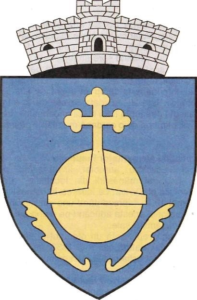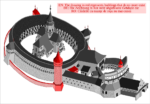Prázsmár

The fortified church of Prázsmár is also called Prejmer, Tartlau as it is situated in Romania. More precisely, it is located in Transylvania, in Saxon Siebenburgen, 20 km northeast of Brassó (Kronstadt, Brasov), close to the Tatrang River. It is a Saxon church on the edge of the Barcaság Region. Everybody will fall in love with this place at once. You can learn more about the Transylvanian Saxons here:
https://www.hungarianottomanwars.com/essays/who-were-the-german-saxons-in-transylvania/
On the main square of the village, there is the Saxon Lutheran fortified church, which is the second most monumental fortress of Barcaság Region, besides Szászhermány (Hărman, Honigberg, Huntschprich). Its fate is similar to that of Szászhermány because the intruding enemy that intruded through the nearest Carpathian Mountain’s passes, the Bodzai and the Ósánci Pass, always bumped first into them. They were too close to the border of Transylvania but it is no wonder because the Székelys and Saxons were border guards of the Kingdom of Hungary.

The first known owner of Prázsmár was Theel of Prázsmár’s son Ditricus, he received the settlement from the Hungarian King Béla IV in 1235, together with the neighboring villages. The church was dedicated to the Holy Cross, it was mentioned in a charter in 1240. The place occurred as Tortaleu in a letter of donation given by King Louis / Lajos the Great (1377). The Turks took it in 1441 but Hunyadi János regained it. The 13th-century church was remodeled in the 15th century. The walls of the half-timbered, Cistercian-type building were hardly altered. At the end of the 15th century, the Béldi family was able to take hold of the Theel family’s property.

Prázsmár became a market town in 1454, and it was mentioned as an agricultural town in the donation letter of King Matthias Corvinus in March 1471. Due to the expansion of the Turks, the local church was surrounded by a defensive wall in the 15th century and it was fortified with bastions. It must have been the Béldi family who assisted in it. We know that Béldi Péter announced the limits of his lands on the town’s market in 1508. However, he was not very popular because the wheel-maker master of Prázsmár beheaded him on the spot with an ax, hearing it. The Voivode of Transylvania inspected the case and made the town pay a fine.

In 1515, King Szapolyai János had his military camp erected near the town and he made further fortifications on the fort. It was timely, as the fortified church was besieged by Voivode István (Stefan V) in 1529, then by the Moldavian Voivode Péter / Petru Rareş who set the city on fire. In both cases, the inhabitants fled into the stronghold and could defend their fort. Voivode Mihály (Michael) marched into Transylvania on October 17, 1599, and his second campsite was in Prázsmár.
The Saxons surrendered to him, yet his soldiers sacked it, and then set the settlement on fire. Three years later, after defeating Voivode Michael, the city was ravaged by the Imperial armies of General Basta. Prázsmár was the place where the Székelys (Hungarian frontier guards of Transylvania) defeated the mercenary army of the city of Brassó in 1612. (The Saxons of Brassó were led by Géczi András.)
In 1661, it was the Ottoman Pasha Ali who ravaged the area and enslaved 80 residents of Prazmar. Next time, Pasha Achmed was camping in the fort of Prázsmár in 1678, and finally, it was the headquarters of Prince Thököly Imre in 1690. He called the Székelys to arms from this fort. In 1704, the rebel Kuruc soldiers of Prince Rákóczi Ferenc caused much destruction in the fortified church, taking 60 inhabitants into captivity at the same time. Two hundred houses in the city burned down in the fire of 1767.
A few words about the architecture of the building:
The main entrance to the church is on the west side, while its side gate is in the middle of the closure of the nave. The altar of the Holy Cross was made around 1450, its stall was carved in 1526 according to the inscription on it. The church is surrounded by a double protective wall with an approximately circular floor plan. Its outer defensive wall was largely destroyed, and only a portion of its foundation walls remained. Its entrance is on the south side, which is reinforced by a polygonal, protruding tower and a fortified front guard. This could only be reached by a wooden bridge that was running through the surrounding deep and wide moat, at the end of which there was a drawbridge.

The moat was flooded by water coming from the surrounding springs. The drawbridge disappeared along with the ditch and it was replaced by a colonnade corridor built in the 19th century. As an entrance, a tunnel-like gate guard was built, which could be closed with oak gates at five places. Underneath the large gate bastion that still exists today, there is still the corridor of the tunnel system, We can still see the drawable guardrail in its original location in the middle of the tunnel.

A total of 275 chambers were built within the fortified church, at a height of two or three floors, with open wooden corridors running in front of them and staircases leading to them. Not only did the Saxon residents find refuge in these chambers, but they also placed their valuables and food there. The chambers are still completely intact today. The settlement itself was once surrounded by a wall with five gates. The fortified church was restored in 1970.

Dear Readers, I can only make this content available through small donations or by selling my books or T-shirts.
If you like my writings, please feel free to support me with a coffee here:
You can check out my books on Amazon or Draft2Digital, they are available in hardcover, paperback, or ebook:
https://www.amazon.com/dp/198020490X
or at https://books2read.com/b/boYd81


My work can also be followed and supported on Patreon: Become a Patron!http://Become a Patron!

[wpedon id=”9140″]

































